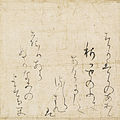| Nomura Art Museum | |
|---|---|
野村美術館 | |
 | |
|
| |
| General information | |
| Address | 61 Nanzenji, Shimokawara-chō, Sakyō-ku |
| Town or city | Kyoto, Kyoto Prefecture |
| Country | Japan |
| Coordinates | 35°00′47″N 135°47′36″E / 35.01294986°N 135.79336226°E |
| Opened | 1984 |
| Website | |
| Official website | |
Nomura Art Museum (野村美術館, Nomura Bijutsukan) opened near Nanzen-ji in Kyoto, Japan, in 1984. The sukiya-style building has two rooms for displaying exhibits and there is also a chashitsu. The collection, based on that built up by financier Tokushichi Nomura II, comprises some 1,700 works ( paintings, calligraphic works, Noh masks, Noh costumes, and tea utensils), including seven Important Cultural Properties and nine Important Art Objects. [1] [2] [3]
Important Cultural Properties
The Museum's seven Important Cultural Properties are Tempest by Sesson Shūkei, [4] Ki no Tomonori from the series Thirty-Six Poetry Immortals formerly in the Satake Collection, [5] calligraphic works by or attributed to Ki no Tsurayuki, [6] Seisetsu Shōchō, [7] and Shūhō Myōchō ( 宗峰妙超), [8] the poetry collection Sanuki no Nyūdō-Shū, [9] and Box for a Noh mask with plovers in maki-e. [10]
-
Tempest by Sesson Shūkei
-
Ki no Tomonori, one of the Thirty-Six Poetry Immortals
-
Sunshōan shikishi ( 色紙), attributed to Ki no Tsurayuki
-
Shūhō Myōchō bokuseki
-
Sanuki no Nyūdō-Shū
See also
References
- ^ 野村文華財団 野村美術館 [Nomura Art Museum] (in Japanese). Agency for Cultural Affairs. Retrieved 21 October 2015.
- ^ "Nomura Art Museum". Kyoto Prefecture. Retrieved 21 October 2015.
- ^ ご案内 [Guide] (in Japanese). Nomura Art Museum. Retrieved 21 October 2015.
- ^ 紙本淡彩風涛図〈雪村筆/〉 [Tempest by Sesson Shūkei] (in Japanese). Agency for Cultural Affairs. Retrieved 21 October 2015.
- ^ 紙本著色三十六歌仙切〈(友則)/佐竹家伝来〉 [Ki no Tomonori, from the series Thirty-Six Poetry Immortals, formerly in the Satake Collection] (in Japanese). Agency for Cultural Affairs. Retrieved 21 October 2015.
- ^ 寸松庵色紙(すかはらのあそん) [Sunshōan Shikishi] (in Japanese). Agency for Cultural Affairs. Retrieved 21 October 2015.
- ^ 清拙正澄墨蹟〈偈頌/庚午孟秋十有七日〉 [Seisetsu Shōchō Bokuseki] (in Japanese). Agency for Cultural Affairs. Retrieved 21 October 2015.
- ^ 大燈国師墨蹟〈偈頌/〉 [Daitō Kokushi Bokuseki] (in Japanese). Agency for Cultural Affairs. Retrieved 21 October 2015.
- ^ 讃岐入道集 [Sanuki no Nyūdō-Shū] (in Japanese). Agency for Cultural Affairs. Retrieved 21 October 2015.
- ^ 千鳥蒔絵面筥 [Box for a Noh Mask with Plovers in Maki-e] (in Japanese). Agency for Cultural Affairs. Retrieved 21 October 2015.
External links
- (in English) Nomura Art Museum
- (in Japanese) Nomura Art Museum





